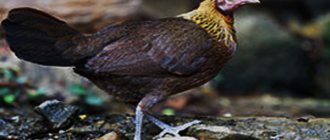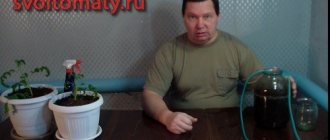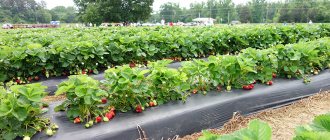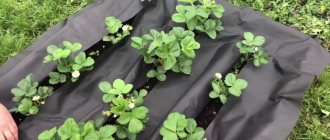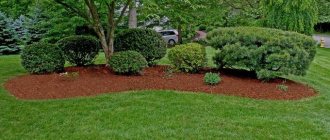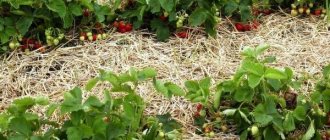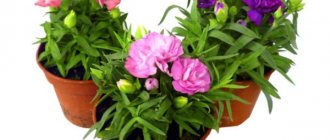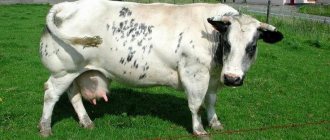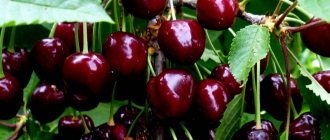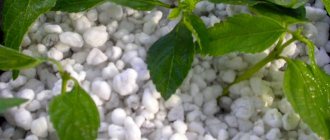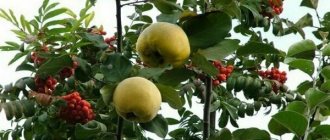0 1238
Nowadays, it is impossible to imagine the work of a gardener without the use of agrofibre. It serves as protection from cold, scorching sun, and strong gusts of wind. There are different types of this material - they differ in color and thickness. This affects what purposes they will be used for. To make the right decision when choosing and purchasing, you need to find out what the features of each type are.
So, what is agrofibre? This is a polypropylene lightweight transparent fabric. Most often it is used to cover beds. For those who are very concerned about the impact of this material on food and health, we hasten to assure you that it is completely safe. Previously, plants, wood chips, and peat were used for shelter. Now agrofibre or, as it is also called, spunbond, has come into use. Thanks to its cellular structure, air and sun rays penetrate through the material quite freely.
Agrofibre: what it is and how to choose the right one
Today it is difficult to imagine how gardeners and vegetable gardeners used to manage without agrofibre - its use has become so common these days. Non-fabric, lutrasil, agril or spunbond - whatever you call it, this material helps us by protecting plants from the cold, from the scorching sun, and from gusty winds. On the shelves of specialized stores you can find agrofibre of different colors and thicknesses. The methods of using a particular brand of product also depend on these indicators. To maximize the effect of using agrofibre, let’s try to figure out for what purposes which material is best used.
Agrofibre - what it is and how to choose the right one.
Advantages of using agrofibre
Initially, agrofibre was intended to replace polyethylene in the manufacture of greenhouses. This environmentally friendly, lightweight and durable non-woven material coped with the task perfectly - the microclimate in such a greenhouse contributed to good germination and development of plants. High humidity, warmth, free penetration of sunlight and air, protection of crops from birds and insects are all advantages that make agrofibre an indispensable shelter.
The homogeneous structure of the polymer fiber, processed in a special way, protects plants from increased ultraviolet radiation. But the most important advantage of non-woven material compared to polyethylene is the protection of plants from overheating. To prevent shoots or seedlings from burning on a sunny day, the film has to be removed or ventilated, which is quite problematic to do if you live far from the garden. Plants covered with agrofibre do not require constant attention.
Which side should the white covering material be placed on? Properties of covering material
When using the material in a garden located in the Moscow region, I draw attention to the characteristics of the canvas:
- the material retains heat, preventing cold air flows from penetrating through it;
- increased breathability in the space created;
- the canvas is uniform over the entire surface - this allows you to create a microclimate inside a closed space: the necessary humidity and temperature;
- light passes through the material;
- the light weight of the material allows you to cover young shoots of crops without exerting pressure, and therefore without causing harm;
- the strength of the material allows it to be wrinkled and washed;
- resistant to low and high temperatures;
- the surface of the canvas is resistant to harmful microorganisms, causing fungi and bacteria to die;
- pesticides and other compounds will not harm the material;
- the material does not emit harmful substances into the atmosphere - it is an environmentally friendly product.
Which side should the spunbond be placed on the ground?
At the beginning of using spunbond, I did not attach any importance to which side to cover the crops with. Then I accidentally came across a discussion among Internet users. At one of the forums dedicated to gardening, summer residents shared their experiences.
It turns out that some manufacturers write on the label where the top and inside sides of the fabric are. But most types of spunbond are produced without explanation.
Any side of the covering material allows water to pass through, but smooth - to a lesser extent, pimply - to a greater extent.
When constructing a greenhouse, spunbond retains all its properties, including thermal insulation, but it is better to have a pimpled surface on the outside and a smooth inside.
White agrofibre with a density from 17 to 23 g/m2
This is a thin agrofibre that transmits sunlight well (approximately 80%), air and moisture. It is not pulled over arcs, but placed directly on the soil. Such a shelter is used after sowing seeds in the ground, and it does not matter whether they are vegetables, flowers or a lawn.
The soil, covered with thin agrofibre, will retain heat and necessary moisture, due to which seedlings will appear faster and be more friendly. As the greens grow, they will be able to lift the fiber, because it is thin and almost weightless, so there is no need to remove it immediately after the sprouts appear.
Until the plants get stronger, they will be reliably protected from the sun, and from the wind, and from birds, and from insect pests. Agrofibre with a thickness of 23 g/m2 can protect crops from return frosts.
The soil, covered with thin agrofibre, will retain heat and necessary moisture, due to which seedlings will appear faster.
White agrofibre with a density from 30 to 42 g/m2
This denser fabric allows approximately 65% of sunlight to pass through. Due to its strength, such agrofibre is suitable not only for covering the soil, but also for arranging greenhouses. It is pulled over metal arcs, secured with clamps and fixed with boards or bricks on the soil.
Under such shelter, seedlings can withstand frosts down to -5°C. In addition, such a greenhouse will protect plants from the scorching sun, wind, hail and even snow, if nature suddenly presents such a surprise.
White agrofibre with a density of 50-60 g/m2
This densest and strongest fiber is also used for greenhouses. Plants in such greenhouses can withstand frosts down to minus 10°C. In addition, thanks to its strength, this fabric can withstand gusty winds, rain, and hail.
Recently, dense agrofibre has become widely used in unheated greenhouses. Many gardeners who have polycarbonate greenhouses set up greenhouses made of dense agrofiber in them, grow seedlings and herbs, and get good results. During the day, the greenhouse warms up, and the greenhouse retains heat throughout the night.
Dense agrofibre is successfully used to cover wintering trees and shrubs. For small plants, as well as for greenhouses, arcs or frames are used over which material is thrown. Fruit trees and conifers are wrapped in agrofibre and secured with twine. This measure protects the plants not only from freezing, but also from sunburn, which often appears on trees in early spring.
In areas with severe frosty winters, it is recommended to cover the plants with agrofibre, folded in two or three layers. The air gap formed between the layers will create additional warmth, and the plants will not suffer even in the most severe frosts.
What types of agrofibre are there?
On sale you can most often find agrofibre in white and black colors, with a density from 17 to 60 g/m2. The higher the number, the thicker the fiber. Sometimes there is a two-color fiber, black and yellow or black and white.
White agrofibre with a density from 17 to 23 g/m2
This is a thin agrofibre that transmits sunlight well (approximately 80%), air and moisture. It is not pulled over arcs, but placed directly on the soil. Such a shelter is used after sowing seeds in the ground, and it does not matter whether they are vegetables, flowers or a lawn.
The soil, covered with thin agrofibre, will retain heat and necessary moisture, due to which seedlings will appear faster and be more friendly. As the greens grow, they will be able to lift the fiber, because it is thin and almost weightless, so there is no need to remove it immediately after the sprouts appear.
Until the plants get stronger, they will be reliably protected from the sun, and from the wind, and from birds, and from insect pests. Agrofibre with a thickness of 23 g/m2 can protect crops from return frosts.
The soil, covered with thin agrofibre, will retain heat and necessary moisture, due to which seedlings will appear faster
White agrofibre with a density from 30 to 42 g/m2
This denser fabric allows approximately 65% of sunlight to pass through. Due to its strength, such agrofibre is suitable not only for covering the soil, but also for arranging greenhouses. It is pulled over metal arcs, secured with clamps and fixed with boards or bricks on the soil.
Under such shelter, seedlings can withstand frosts down to -5°C. In addition, such a greenhouse will protect plants from the scorching sun, wind, hail and even snow, if nature suddenly presents such a surprise.
White agrofibre with a density of 50-60 g/m2
This densest and strongest fiber is also used for greenhouses. Plants in such greenhouses can withstand frosts down to minus 10°C. In addition, thanks to its strength, this fabric can withstand gusty winds, rain, and hail.
Recently, dense agrofibre has become widely used in unheated greenhouses. Many gardeners who have polycarbonate greenhouses set up greenhouses made of dense agrofiber in them, grow seedlings and herbs, and get good results. During the day, the greenhouse warms up, and the greenhouse retains heat throughout the night.
Dense agrofibre is successfully used to cover wintering trees and shrubs. For small plants, as well as for greenhouses, arcs or frames are used over which material is thrown. Fruit trees and conifers are wrapped in agrofibre and secured with twine. This measure protects the plants not only from freezing, but also from sunburn, which often appears on trees in early spring.
In areas with severe frosty winters, it is recommended to cover the plants with agrofibre, folded in two or three layers. The air gap formed between the layers will create additional warmth, and the plants will not suffer even in the most severe frosts.
Black agrofibre with a density of 50-60 g/m2
Dense black agrofibre is most often used as a mulching material. It is placed directly on a dug up and fertilized bed. The edges of the fabric are fixed with special pins or pressed with boards. Crosswise cuts are made on the fiber at the required intervals and plants are planted in the resulting holes.
Read more about mulching with agrofibre in the material More about mulching the soil.
Most often, this method is used when growing garden strawberries, killing several birds with one stone:
- watering is reduced, because the soil under the spunbond does not overheat or dry out;
- there is no need for constant weeding - weeds cannot break through the dense fabric;
- the berries remain clean even during heavy rainfalls and, as a result, there is no rot or other troubles that often occur from contact of fruits with the ground;
- soil pests, especially slugs, which so often pester strawberries, cannot cause any harm to the berry.
Black agrofibre is also used when growing vegetables, acting on the same principle as when planting strawberries. After harvesting, the fruit-bearing plants are removed, and the lutrasil is shaken out, dried and stored until next year.
Non-woven fabric can remain on beds with strawberries for several years until it becomes unusable, but by that time, as a rule, it is time to renew the planting of berries.
Black Lutrasil is often used in landscape design. When laying garden paths, agrofibre is laid under tiles, and when arranging decorative islands - under marble chips, bark, wood chips or cones. If this is not done, then weeds appearing here and there will disrupt the harmony and add unnecessary work to weed control.
Black agrofibre is an excellent mulching material. © KakProsto
Black-yellow and black-white agrofibre
Both types are an improved version of black fiber. They are used as a mulching material and laid on the soil with the light side up. At the same time, the black side does not allow sunlight to pass through and prevents weeds from growing, and the light side prevents overheating of the soil. Two-color agrofibre is also used in landscape design, as a lining for light marble chips.
Many novice summer residents confuse concepts such as agrofibre and agrofabric (agrotextiles). These are different materials: agrofibre is NOT a woven material, but agrofabric is, accordingly, woven. The density of agrotextiles is much higher - 90, 100, 120, 130 g/m² and it is mainly used only for mulching.
Black agrofibre with a density of 50-60 g/m2
Dense black agrofibre is most often used as a mulching material. It is placed directly on a dug up and fertilized bed. The edges of the fabric are fixed with special pins or pressed with boards. Crosswise cuts are made on the fiber at the required intervals and plants are planted in the resulting holes.
Black agrofibre.
Most often, this method is used when growing garden strawberries, killing several birds with one stone:
- watering is reduced, because the soil under the spunbond does not overheat or dry out;
- there is no need for constant weeding - weeds cannot break through the dense fabric;
- the berries remain clean even during heavy rainfalls and, as a result, there is no rot or other troubles that often occur from contact of fruits with the ground;
- soil pests, especially slugs, which so often pester strawberries, cannot cause any harm to the berry.
Black agrofibre is also used when growing vegetables, acting on the same principle as when planting strawberries. After harvesting, the fruit-bearing plants are removed, and the lutrasil is shaken out, dried and stored until next year.
Application of black agrofibre.
Non-woven fabric can remain on beds with strawberries for several years until it becomes unusable, but by that time, as a rule, it is time to renew the planting of berries.
How to cover the beds: (read more)
Black Lutrasil is often used in landscape design. When laying garden paths, agrofibre is laid under tiles, and when arranging decorative islands - under marble chips, bark, wood chips or cones. If this is not done, then weeds appearing here and there will disrupt the harmony and add unnecessary work to weed control.
Black agrofibre is an excellent mulching material.
How to use agrofibre correctly?
Use of white agrofibre of low density 17-23 g/m2.
The planted seedlings or the area with the seeds are simply covered with material on top, which must be secured at the edges with pegs, soil, or other available means. Canvas with a density of 17 g/m2. transmits 80% of light, but protects against frost the weakest - down to -3°C; while 23 g/m2 – down to -5°С. When selecting a suitable density, it is recommended to focus on the climate in the area, the planting period and the type of crops being planted.
Use of white agrofibre with a density of 30-50 g/m2.
Since plants cannot withstand the weight of a covering material with a density of 30 g/m2. and higher, there is a need to build greenhouses or greenhouses. When selecting the required density, you should be guided by the above principles, as well as the type of structure being constructed: the higher it is, the denser the agrofibre should be.
This material is also used to cover grapes and other garden crops for the winter. The canvas is ideal for regions with mild winters. But if you live in a region with long-term strong drops in temperature, it is recommended to combine agrofibre with other materials.
Using mulching agrofibre
Black agrofibre is most often used when growing strawberries. The installation method is quite simple: holes are cut in the canvas (there is also material with ready-made holes on sale); spread on the area where the crop will be grown; after which seedlings are planted into the holes.
This material can be used for several seasons.
Which side should you lay agrofibre on?
If you have never used agrofibre before, you will probably wonder whether it matters which side to lay this covering material. In fact, this does not play any role, since the canvas on both sides has a uniform structure. The exception is black and white agrofibre: it must be laid with the white side up, which is designed to reflect the sun's rays.
Agrofibre is an indispensable thing on the site. If you want to reap a rich harvest and take care of your garden, agrofibre is the ideal solution.
If you want to get the maximum yield from your plot, you should buy agrofibre in the budsite online store at the lowest price in Ukraine! We will provide competent advice on selection, use and deliver to any region in the shortest possible time. You will be satisfied with the choice of material and cooperation with us.
Black-yellow and black-white agrofibre
Both types are an improved version of black fiber. They are used as a mulching material and laid on the soil with the light side up. At the same time, the black side does not allow sunlight to pass through and prevents weeds from growing, and the light side prevents overheating of the soil. Two-color agrofibre is also used in landscape design, as a lining for light marble chips.
Note! Many novice summer residents confuse concepts such as agrofibre and agrofabric
What is agrofibre
Agrotextile or agrofibre is an environmentally friendly, lightweight and durable non-woven material made from polypropylene fibers. Contrary to popular belief, this material is not toxic or harmful to the environment. It is harmless to animals, insects and plants. It has the ability to pass water and does not get wet, which does not put additional stress on the plants and structure. The use of agrofibre in vegetable growing helps to obtain an early and fairly high harvest.
Agrofibre for greenhouses and greenhouses
Agrofibre or agrofabric: difference and application
These are different materials: agrofibre is a non-woven material, and agrofabric, accordingly, is woven. The density of agrotextiles is much higher - 90, 100, 120, 130 g/m².
How does agrofibre differ from agrofabric?
It is used as a mulching material to protect the soil from weeds, conserve moisture, conserve heat and energy. Agrofabric differs from other mulching materials in its very high strength and increased UV resistance.
How does agrofabric differ from agrofibre: (read more)
The material is spread on the surface of the soil and secured at the edges. The surface can be either flat or ridged.
When planting, use a simple knife to make cross-shaped slits. For ease of planting, there are markings in 15*15 cm stripes. Then seedlings or seeds are planted in the slots. You can lay the drip tape under or on top of the Agrofabric.
With this use, you can forget about weeds and their weeding, frequent watering and loosening the soil after them, dirt between the rows and dirty fruits after rain or watering.
Water directly on the Agrofabric - the fruits will always be clean and will not rot or be damaged by pests (mole crickets, etc.) from the soil - there is no contact with the ground! You can safely walk, water, and harvest on Agrofabric - it won’t tear (unlike film and spunbond).
Precipitation in the form of rain or irrigation passes through the Agrofabric and is evenly preserved, while the structure of the earth or soil always remains loose.
Unlike film, no accumulations of water (puddles) form on the surface of the Agrofabric and the soil does not “suffocate” from excess moisture, but allows dosed air and moisture to pass through, creating an optimal microclimate for the root system of plants!
Service life is 5-7 years without removal for the winter.
Black spunbond
This is a mulching agrofibre, the main purpose of which is weed control. It is especially convenient to use it when growing strawberries and strawberries. The material is spread on the surface of the prepared soil, after which small cross-shaped holes are cut out in it, into which the seedlings are planted. This agrofibre can be used to cover the gaps between rows or near-trunk areas of bushes and trees.
Due to the fact that the soil underneath warms up well, the development of the root system occurs much faster, and in winter it is well preserved under such shelter. There is much less moisture evaporation, and therefore there is no need for frequent watering. In addition, this material protects the soil from compaction and mold. The absence of contact of berries and fruits with the ground keeps them clean and reduces the possibility of rotting. Black agrofibre is an environmentally friendly material, harmless to humans and plants. In areas with perennial crops it can be present all year round.
How long will agrofibre last?
The service life of agrofibre depends on many indicators:
- on strength - as a rule, dense brands of fiber have higher strength and last longer;
- UV stabilization (from decomposition of the material under the influence of sunlight) - if this indicator is present in agrofibre, the shelter will last about 3 years;
- careful use - if during operation it was possible to avoid fiber ruptures, which often occurs due to gusts of wind and improper fastening, then the agrofibre will also serve for several years.
Even if the agrofibre breaks and it cannot be used as a greenhouse, the mulching and heat-storing properties of the material will not go away. Damaged canvas can be used when covering perennials for the winter, mulching the soil, and arranging small seedling beds.
What covering materials are used for beds: (read more)
In general, as many years of experience show, the use of agrofibre in gardening, vegetable gardening and landscape design is not a luxury. This inexpensive but durable material allows you to effectively solve a variety of problems, thereby facilitating the work of growing healthy plants and landscaping the site.
